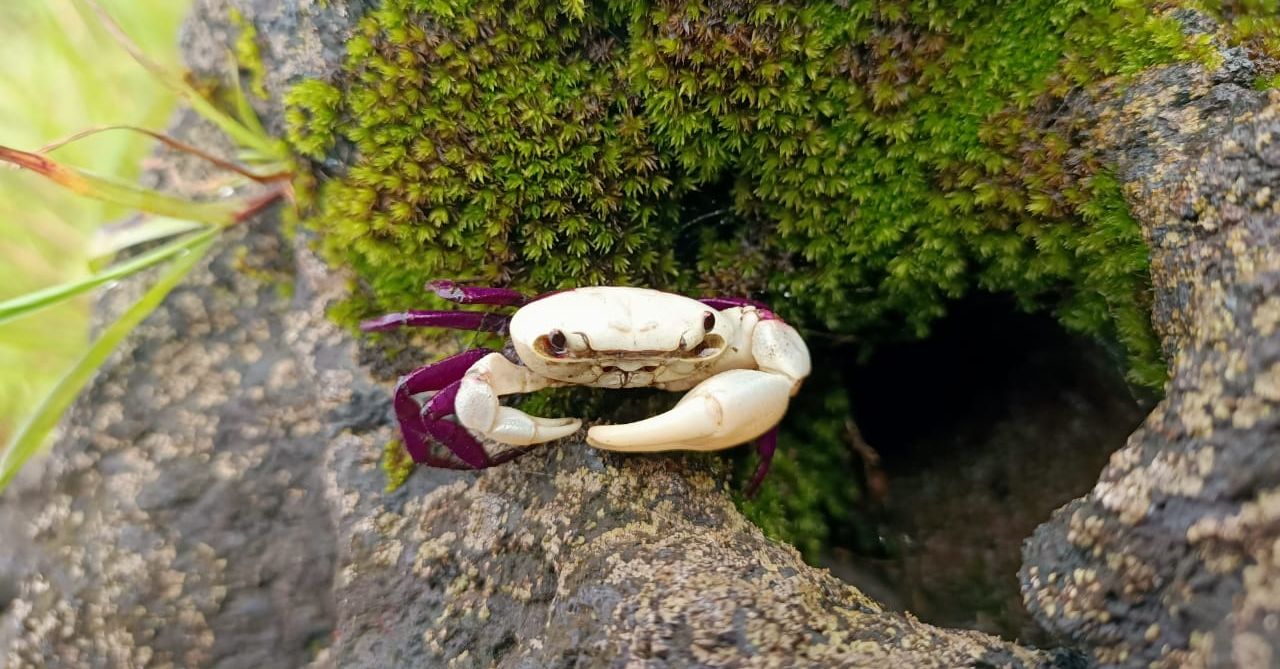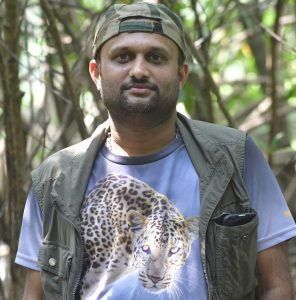A forest guard from the Karnataka Forest Department and a naturalist found the 75th fresh water crab species in the Western Ghats.

The Ghatiana Dvivarna crab species. (Supplied)
A forest guard and a naturalist headed into the green expanse of Idagundi forests in Karnataka’s Yellapur district, one longing to photograph the great hornbill and the other to spot a pit viper. Neither expected to discover a new species of crab.
Also, neither has an advanced degree in the field. One has cleared his SSLC exams — equivalent to Class X exams at the state education board level — and the other is a graduate of arts.
However, walking into the jungle to spot the snake, Parashuram Prabhu Bajantri of the Anshi Wildlife Range’s Kali Tiger Reserve Division under the Karnataka Forest Department, and Gopalkrishna Dattatraya Hegde spotted an as-yet-unknown freshwater crab and the made history.
They are being recognised along with scientists from the Zoological Survey of India, and have even published their findings in an international scientific journal.
South First spoke with the duo about how they knew this crab was special and their journey from finding the crab to identifying it, naming it, and then making it to the scientific journal.
“I am a political science and history student, but my tryst with understanding trees, butterflies, varieties of snakes, spiders, frogs, and crabs began 10 years ago when I started working as a forest guard,” said Bajantri.
“Serving at Kali Tiger Reserve’s Anshi forests, I have been trained as a snake rescuer as well. During my duty hours, I took interest in learning about identifying and observing the nature and behaviour of every single species I saw, besides monitoring the regular activities in the forests,” he explained.
Bajantri liked meeting like-minded people, and that’s how he met naturalist Gopalakrishna Hegade, a native of the Yellapur region of the state.
Bajantri, who had met Reliance Foundation Head Scientist Varad Giri, a herpetologist, said each time he found any species of frog or snake, he would take a photograph of it and would send it to Giri for identifying it.
“I would then write it in my notebook. I didn’t only photograph them. I would even draw the features of the frog, note down its mood, and even the comments I had passed after seeing the frog. Associate it with different human nature etc. I had the habit of jotting this down, and this habit paid off,” said Bajantri.
The duo, on 30 June last year, set out to look for a viper near the Suryakalyani mountains. Instead of the snake, they spotted a unique crab.
“I spotted the unique colours on the crab. It had two colours: purple and white. This was unique,” they said.

Gopalkrishna Dattatraya Hegde, a naturalist who along with the forest guard found new species of crab ‘Ghatiana Dvivarna’. (Supplied)
Hegde told South First, “We had seen several crabs in this region. Almost all varieties are known to us. So, when I saw this one, I told Bajantri, ‘This looks like a new species. Let’s photograph and send it to Giri’.”
Giri saw the picture and immediately called Bajantri and said it looked like “you have stumbled upon a new species”, and that “this might be big news”.
He took five minutes to confirm and said he had spread the word to a few other scientists, who had asked for details and also observations on the crab’s movement and behaviour.
An excited Bajantri and Hegde began observing the movement of the crab species, but they had to name it first.
The duo first thought of naming it according to the region it was found, or the name of their village.
“We wanted to call it Bare, the name of our village in the Uttara Kannada district, which is in the central Western Ghats, and that is where the crab was found. But then we decided to name it according to its features, and the prominent feature of this new species was the two colours,” they said
Hence, they called it “Dvivarna”, which means two colours in Sanskrit.
Scientists Sameer Kumar Pati of the Zoological Society of India and Tejas Thackeray of the Thackeray Wildlife Foundation in Mumbai helped the duo ascertain that the crab species belonged to the Indian genus of freshwater crabs of the family Gecarcinucidae Rathbun, which was previously known to have 10 species in Goa, Karnataka, and Maharashtra.
Pati and Thackrey published papers on this in 2018 and 2021.
The new crab was also identified as the 75th species of freshwater crab in the Western Ghats. It was hence given a final name “Ghatiana Dvivarna”.
Later, Bajantri and Hegde began to observe the very nature of the crab, from the way it carries its eggs to the way it halts activities during the rainy season.
Bajantri explained: “The activities of this crab species minimise when the rain halts, and they can then be found in the rocky holes filled with rainwater. Some of them were found eating mosses growing on laterite rocks. Meanwhile, females carry juvenile crabs like a kangaroo carries its babies.”
Pati and Thackrey looked into the unique physical characteristics of the species.
The scientists told South First that this particular crab species was the 11th of the Ghatiana species.
An excited Bajantri and Hegde then began sending out all the collected information to the researchers who came to the terrain and also helped the duo gather more information about the species, which was finally put together in the form of a research paper and sent to scientific journals.
Almost a year later, the paper was accepted in Nauplius, the Journal of the Brazilian Crustacean Society, in February.
“We were thrilled that on the 75th year of Indian Independence, two common men with no scientific background had managed to find the 75th new species of our Western Ghats,” said Bajantri.
He added that the forests are a cornucopia, and every time they are out on duty he notices something new.
The duo said in unison, “We don’t know which new species is out there waiting for us to see. Our excitement has no boundaries now.”
While Hegde appreciates the friendship between forest guards and naturalists and several wildlife buffs who visit, Bajantri said there are many like him in the Karnataka Forest Department.
He said, from a watcher to a guard, there are several people in the department who are interested to know more about species in the wildlife.
“While I have on my own attended several workshops on butterflies, elephants, trees, etc, it would be very beneficial if the department conducted workshops such as these in all forest ranges. There are many like me in our department and they will definitely benefit,” said Bajantri.

Apr 19, 2024

Apr 19, 2024

Apr 19, 2024

Apr 19, 2024

Apr 19, 2024